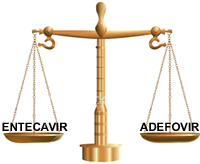By
Liz Highleyman
 Entecavir
and adefovir are a nucleoside
and nucleotide analog, respectively, widely used for treatment
of chronic hepatitis B virus
(HBV) infection. Antiviral agents such as these have
potent antiviral activity, but HBV often rebounds when therapy
is discontinued and the virus can develop resistance that
compromises long-term effectiveness.
Entecavir
and adefovir are a nucleoside
and nucleotide analog, respectively, widely used for treatment
of chronic hepatitis B virus
(HBV) infection. Antiviral agents such as these have
potent antiviral activity, but HBV often rebounds when therapy
is discontinued and the virus can develop resistance that
compromises long-term effectiveness.
As
described in the February
22, 2011, online edition of Virology Journal,
Pan Zhao from the Therapy and Research Center for Liver
Failure in Beijing and colleagues conducted a meta-analysis
to compare 48-week efficacy of the 2 drugs in hepatitis
B "e" antigen (HBeAg) positive nucleoside/nucleotide-naive
Asian chronic hepatitis B patients.
A previous meta-analysis was limited to English-language
publications and did not classify patients according to
region, the study authors noted as background. But research
indicates that Asian hepatitis B patients -- who are often
infected at birth in endemic regions -- have some characteristics
that differ from western populations, such as less durability
of HBeAg responses after stopping therapy.
The Chinese investigators searched medical literature databases
(Pubmed, Embase, Wanfang Database, and China National Knowledge
Infrastructure) for relevant studies comparing entecavir
and adefovir published through November 30, 2010. They included
randomized clinical trials that lasted 48 weeks and tested
0.5 mg/day entecavir and 10 mg/day adefovir. They excluded
studies in which participants had hepatitis C, HIV, or other
coinfections, hepatocellular carcinoma, or liver transplants.
The researchers evaluated rates of undetectable HBV DNA
viral load, alanine aminotransferase (ALT) normalization,
HBeAg clearance, and HBeAg seroconversion.
Results
 |
6
studies meeting the eligibility criteria (1 English,
5 Chinese) were included in the meta-analysis; 1 was
an international study with a majority of Asian patients. |
 |
In the combined analysis, significantly more patients
taking entecavir achieved undetectable HBV DNA than
those taking adefovir (65% vs 36%; relative risk 1.73). |
 |
More
people in the entecavir arms experienced ALT normalization
compared with the adefovir arms (71% vs 56%; relative
risk 1.25). |
 |
However,
there were no statistically significant differences
between entecavir and adefovir recipients with regard
to rates of HBeAg clearance (11% vs 13%; relative risk
0.77) or HBeAg seroconversion (6% vs 8%; relative risk
0.74). |
Based on these findings, the investigators wrote, "Entecavir
is superior to adefovir in decreasing serum HBV DNA and
normalizing ALT but similar [to] adefovir in clearing HBeAg
and encouraging HBeAg seroconversion" for HBeAg positive
nucleoside/nucleotide-naive Asian patients with chronic
hepatitis B.
While
entecavir performed better overall, the authors concluded
that, "Adefovir can be still used for first-line therapy
in these patients."
Investigator
affiliations: Therapy and Research Center for Liver Failure,
Beijing 302 Hospital, Beijing, China; Science and Technology
Division, Academy of Military Medical Science, Beijing,
China.
3/29/11
Reference
P
Zhao, W Liu, J Zhao, and Q Guan. Comparison of the 48-week
efficacy between entecavir and adefovir in HBeAg-positive
nucleos(t)ide-naive Asian patients with chronic hepatitis
B: a meta-analysis. Virology Journal 8(1): 75 (free
full text). February 22, 2011.
